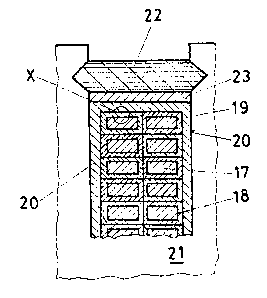Some of the information on this Web page has been provided by external sources. The Government of Canada is not responsible for the accuracy, reliability or currency of the information supplied by external sources. Users wishing to rely upon this information should consult directly with the source of the information. Content provided by external sources is not subject to official languages, privacy and accessibility requirements.
Any discrepancies in the text and image of the Claims and Abstract are due to differing posting times. Text of the Claims and Abstract are posted:
| (12) Patent Application: | (11) CA 2094482 |
|---|---|
| (54) English Title: | HIGH-VOLTAGE INSULATION FOR STATOR WINDINGS OF ELECTRIC MACHINES |
| (54) French Title: | ISOLATION HAUTE TENSION POUR ENROULEMENTS D'INDUIT DE MOTEURS ELECTRIQUES |
| Status: | Deemed Abandoned and Beyond the Period of Reinstatement - Pending Response to Notice of Disregarded Communication |
| (51) International Patent Classification (IPC): |
|
|---|---|
| (72) Inventors : |
|
| (73) Owners : |
|
| (71) Applicants : |
|
| (74) Agent: | NORTON ROSE FULBRIGHT CANADA LLP/S.E.N.C.R.L., S.R.L. |
| (74) Associate agent: | |
| (45) Issued: | |
| (22) Filed Date: | 1993-04-20 |
| (41) Open to Public Inspection: | 1993-12-11 |
| Examination requested: | 2000-04-06 |
| Availability of licence: | N/A |
| Dedicated to the Public: | N/A |
| (25) Language of filing: | English |
| Patent Cooperation Treaty (PCT): | No |
|---|
| (30) Application Priority Data: | ||||||
|---|---|---|---|---|---|---|
|
ABSTRACT OF THE DISCLOSURE
The conductor bars of stator windings of
rotating electric machines are usually multiply wound
around with two-layer mica strips as major insulation
and then impregnated with synthetic resin. It is
proposed to use as first layer (L1) a mica strip which
is provided on both sides with a textile carrier (24,
25). The further layers (L2, L3, L4, ...) are then
wound with a mica strip (27) provided with a textile
carrier (28) only on one side.
A major insulation constructed in this way is
very homogeneous. The textile carrier (24), preferably
consisting of glass fabric, which bears directly on the
conductor surface, optimizes the impregnation and
produces an effective bond between the insulation and
conductor.
(Figure 3)
Note: Claims are shown in the official language in which they were submitted.
Note: Descriptions are shown in the official language in which they were submitted.

2024-08-01:As part of the Next Generation Patents (NGP) transition, the Canadian Patents Database (CPD) now contains a more detailed Event History, which replicates the Event Log of our new back-office solution.
Please note that "Inactive:" events refers to events no longer in use in our new back-office solution.
For a clearer understanding of the status of the application/patent presented on this page, the site Disclaimer , as well as the definitions for Patent , Event History , Maintenance Fee and Payment History should be consulted.
| Description | Date |
|---|---|
| Inactive: IPC from MCD | 2006-03-11 |
| Application Not Reinstated by Deadline | 2003-04-22 |
| Time Limit for Reversal Expired | 2003-04-22 |
| Deemed Abandoned - Conditions for Grant Determined Not Compliant | 2002-07-24 |
| Deemed Abandoned - Failure to Respond to Maintenance Fee Notice | 2002-04-22 |
| Notice of Allowance is Issued | 2002-01-24 |
| Notice of Allowance is Issued | 2002-01-24 |
| Letter Sent | 2002-01-24 |
| Inactive: Approved for allowance (AFA) | 2002-01-09 |
| Letter Sent | 2000-04-27 |
| Inactive: Status info is complete as of Log entry date | 2000-04-27 |
| Inactive: Application prosecuted on TS as of Log entry date | 2000-04-27 |
| All Requirements for Examination Determined Compliant | 2000-04-06 |
| Request for Examination Requirements Determined Compliant | 2000-04-06 |
| Application Published (Open to Public Inspection) | 1993-12-11 |
| Abandonment Date | Reason | Reinstatement Date |
|---|---|---|
| 2002-07-24 | ||
| 2002-04-22 |
The last payment was received on 2001-03-27
Note : If the full payment has not been received on or before the date indicated, a further fee may be required which may be one of the following
Please refer to the CIPO Patent Fees web page to see all current fee amounts.
| Fee Type | Anniversary Year | Due Date | Paid Date |
|---|---|---|---|
| MF (application, 5th anniv.) - standard | 05 | 1998-04-20 | 1998-03-23 |
| MF (application, 6th anniv.) - standard | 06 | 1999-04-20 | 1999-03-22 |
| MF (application, 7th anniv.) - standard | 07 | 2000-04-20 | 2000-03-17 |
| Request for examination - standard | 2000-04-06 | ||
| MF (application, 8th anniv.) - standard | 08 | 2001-04-20 | 2001-03-27 |
Note: Records showing the ownership history in alphabetical order.
| Current Owners on Record |
|---|
| ASEA BROWN BOVERI LTD. |
| Past Owners on Record |
|---|
| ROLAND SCHULER |